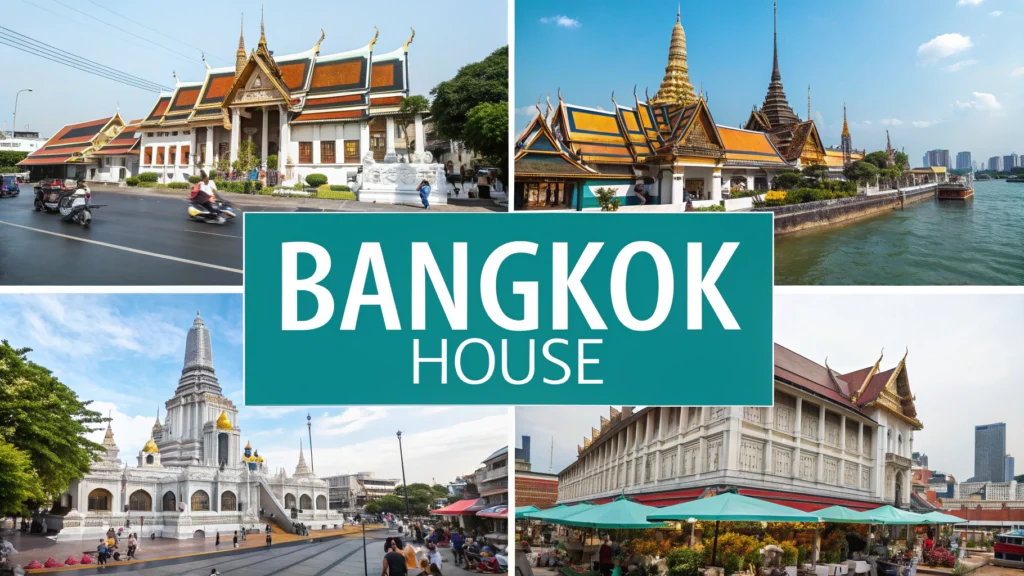I still remember the first time I stepped into a traditional Bangkok House. It was sweltering—like, makeup-melting-off-your-face hot—and I was desperately lost somewhere between Chinatown and the river. That’s when I stumbled upon this unassuming wooden structure that seemed to exist in its own little bubble of time, completely unfazed by the chaos of 21st century Bangkok surrounding it.
Listen, Bangkok isn’t just another Asian metropolis with fancy rooftop bars and traffic (though it definitely has both in abundance). This city has soul—complex, contradictory, sometimes frustrating, but always fascinating. I’ve been coming back to Thailand’s capital almost yearly since 2015, and each time I discover something new about traditional Thai architecture and the stories these historic homes tell.
So fair warning: this isn’t your typical “10 Best Instagram Spots in Bangkok” guide. Nope. We’re going deep into the world of the traditional Bangkok House, from museum-quality preserved mansions to boutique hotels where you can actually experience these architectural treasures firsthand. And yes, I’ve personally stayed in, visited, or at minimum pressed my face against the windows of every place mentioned here.
Oh, and I should probably mention—I once accidentally walked into someone’s private residence thinking it was a museum. So… learn from my mistakes, okay?
What Exactly IS a Traditional Bangkok House?
Before we dive into specific recommendations, let’s talk about what makes a Bangkok House unique. Traditional Thai houses are typically:
- Elevated on stilts (historically to avoid flooding and creepy-crawlies)
- Made primarily of teak wood (which smells AMAZING, by the way)
- Built without nails (seriously, it’s all interlocking wood—mind-blowing craftsmanship)
- Perfectly adapted to the climate (those steep roofs? They’re for monsoon rains)
- Modular in design (houses could be disassembled and moved—the original mobile homes!)
What I love most about these structures is how they represent the ultimate marriage of form and function. Nothing is purely decorative—every element serves a purpose while still managing to be absolutely gorgeous. In our world of disposable IKEA furniture, there’s something profoundly moving about spaces designed to last for generations.
Jim Thompson House: The Gateway Drug to Bangkok House Obsession
Let’s start with the classic. Jim Thompson House is often the first (and sometimes only) traditional Thai house that tourists visit, and for good reason. Located right in central Bangkok, this complex of six traditional Thai houses was the home of American businessman Jim Thompson, who mysteriously disappeared in Malaysia in 1967.
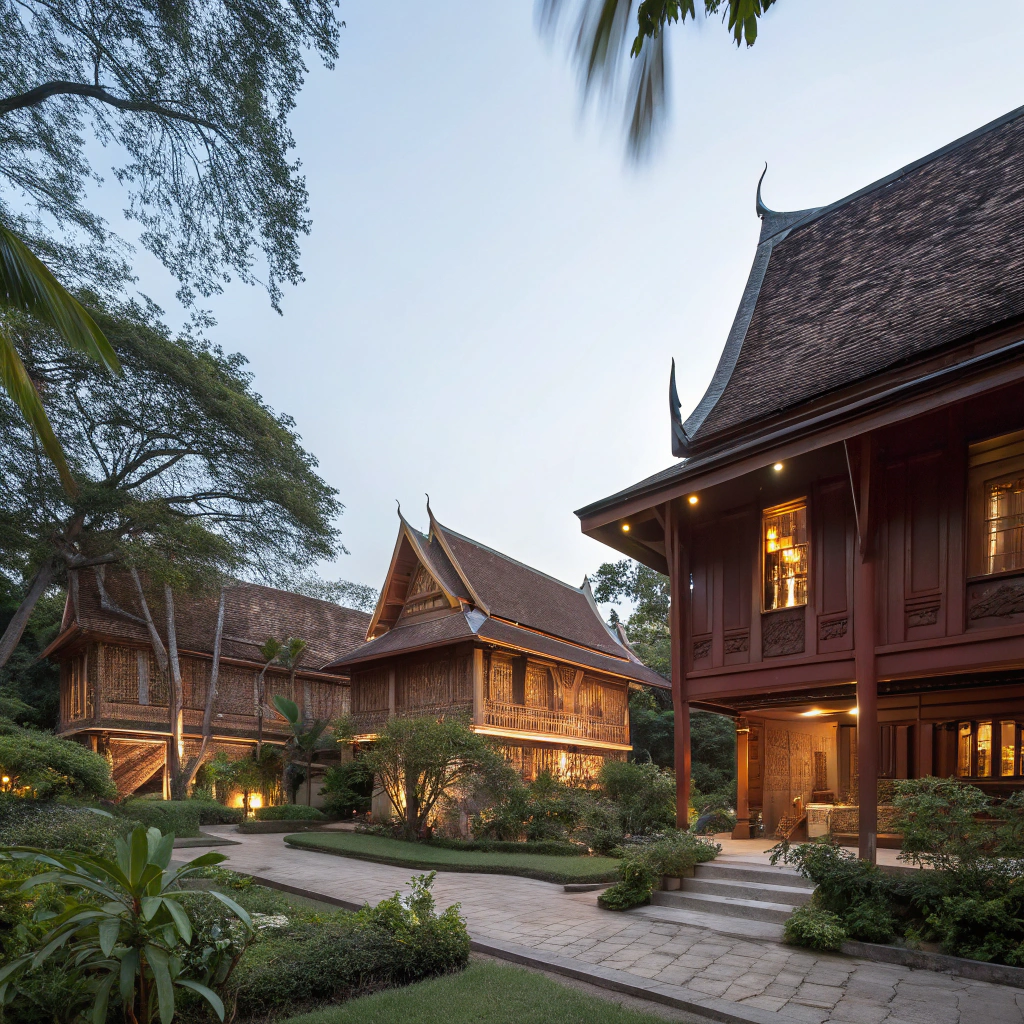
The first time I visited was during a particularly nasty hangover (those Khao San Road buckets are no joke), and even in my fragile state, I was blown away. The house is a masterclass in traditional Thai architecture with a subtle Western influence—Thompson collected the various structures from different parts of Thailand and had them reassembled here.
You’ll need to join a guided tour (they run every 20-ish minutes, though the schedule seems… flexible). Our guide, Tik, had clearly given this tour thousands of times but still managed to sound genuinely enthusiastic about Thompson’s collection of Buddha sculptures and Chinese porcelain.
Insider tip: Go early! Like, be-there-when-they-open early. By midday, it gets crowded, and trust me, you want to be able to take your time absorbing the details. Also, their gift shop has legitimately nice silk products that aren’t crazy expensive (I still use a scarf I bought there five years ago).
How to get there: Take the BTS to National Stadium station and it’s about a 10-minute walk. Look for the small green sign on Soi Kasemsan 2 – it’s easy to miss! If you get lost, just ask anyone for “Baan Jim Thompson” and they’ll point you in the right direction.
Kamthieng House: The Hidden Gem Most Tourists Miss
Now here’s where we start getting off the beaten path. While everyone’s crowding into Jim Thompson House, Kamthieng House Museum sits quietly by the Asok BTS station, largely ignored by tourists. Their loss!
This 19th-century northern Thai teak house originally stood in Chiang Mai before being dismantled and rebuilt in Bangkok. It sits on the grounds of the Siam Society and houses an ethnological museum that showcases traditional Lanna (northern Thai) living.
What makes Kamthieng special is how thoroughly it transports you out of modern Bangkok. One second you’re walking past Starbucks and Terminal 21 mall, and the next you’re in a tranquil garden surrounding a stunning wooden house that seems to have been plucked straight from rural Thailand a century ago.
When I visited in 2018, I was literally the only visitor for almost an hour. The caretaker was so excited to have someone interested that she gave me an impromptu extended tour, showing me details I never would have noticed, like the spiritual symbols carved into seemingly decorative elements of the house.
Hot take: I actually prefer Kamthieng to Jim Thompson. There, I said it! While less elaborate, it feels more authentic and less “curated for Western tastes.”
How to get there: Exit 3 from Asok BTS station. You’ll see it right there on the corner of Sukhumvit and Soi 21. Entry fee is just 100 baht.
Suan Pakkad Palace: Royal Living on Display
Formerly the residence of Prince and Princess Chumbhot of Nagara Svarga, Suan Pakkad Palace is now a museum complex featuring eight traditional Thai houses connected by covered walkways.
I’ll be honest, I almost skipped this place on my second trip to Bangkok. It was a sweltering April day, and the thought of touring yet another historic house had me thinking “been there, done that.” Boy, am I glad my friend Pai insisted we go!
The highlights here are the Ban Chiang archaeological collection (prehistoric pottery that’s way more interesting than it sounds) and the absolutely breathtaking Lacquer Pavilion, which features some of the most intricate gold and black lacquer murals I’ve ever seen. Dating from the 17th century, this little building alone is worth the trip.
What I love about Suan Pakkad is how it shows the evolution of the Bangkok House when adapted for royal living. It’s still recognizably Thai in design, but with extra flourishes and luxurious touches that hint at its aristocratic residents.
Practical info: It’s open daily except Mondays from 9am to 4pm. Entrance fee is 100 baht.
Quick rant: Their website is perpetually out of date, and when I visited in 2019, the opening hours posted online were wrong. Maybe call ahead if you’re on a tight schedule?
Stay in a Traditional Bangkok House: Boutique Hotels with Historic Charm
Looking at these houses is one thing, but actually staying in one? That’s next-level cultural immersion. Here are some places where you can experience traditional Thai architecture while still enjoying modern comforts (because let’s face it, we all want authentic experiences… but also air conditioning).
Chakrabongse Villas
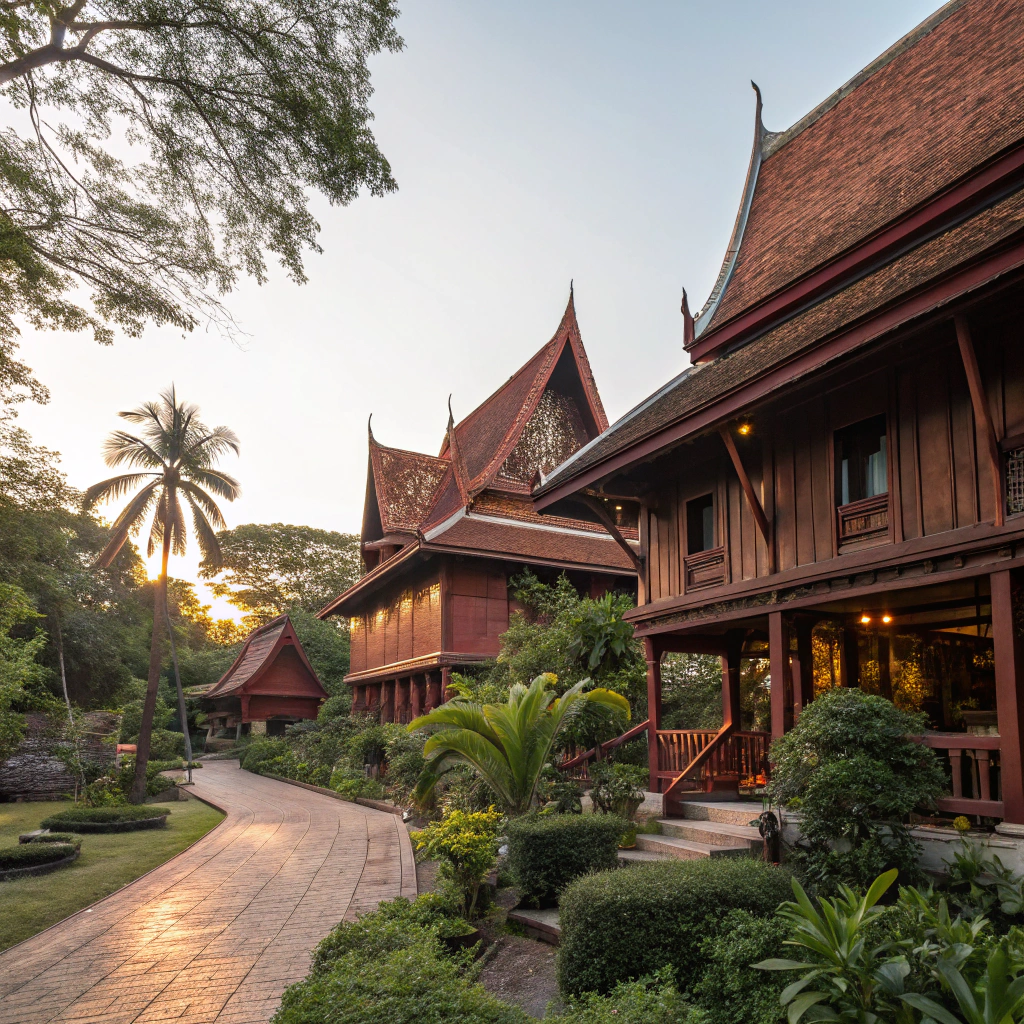
Y’all. This place is RIDICULOUS. In the best possible way. Hidden behind high walls right near the Grand Palace sits Chakrabongse Villas, built in 1908 by Prince Chakrabongse. With just a handful of rooms set in lush tropical gardens alongside the Chao Phraya River, this place feels more like you’re a guest of royalty than staying at a hotel.
I splurged on one night here in 2017 (I normally stay in places that cost about 1/4 the price), and it remains one of my most memorable Bangkok experiences. Waking up to breakfast on a private terrace, watching longtail boats zip past on the river while sitting in a house that’s over a century old—it’s pure magic.
The Thai House is the most traditional option, showcasing classic Bangkok House architecture with modern amenities subtly integrated. The four-poster bed with mosquito netting feels both practical and romantic, and the dark teak wood throughout creates this cocoon-like atmosphere that’s incredibly calming amid Bangkok’s chaos.
The catch: It’s expensive (starting around $250/night) and books up WAY in advance. Plan ahead!
Worth it for: A special occasion splurge that’s more unique and authentically Thai than any luxury hotel chain.
The Siam
If Chakrabongse is old-world Thai charm, The Siam is what happens when you blend traditional Bangkok House elements with ultra-sleek contemporary design. Owned by a Thai rock star (seriously), this boutique hotel in the Dusit district features a collection of century-old Thai teakwood houses that were dismantled from their original locations and rebuilt within this luxury property.
Full disclosure: I haven’t actually stayed here (it’s seriously pricey), but I did have a fancy cocktail at their riverside bar and managed to “get lost” on my way to the bathroom, wandering through enough of the property to get a good feel for it. The houses contain some of their premium suites and common areas, and they’re stunning—all the traditional architectural elements but with contemporary furnishings and art.
What makes this place special is that it doesn’t feel like a museum. The historic structures have been given new life as functional, livable spaces that honor their heritage while embracing modern design.
Not-so-budget-friendly: Rooms start at about $500/night, but if you’ve got the cash, wow.
Consolation prize: Even if you can’t afford to stay, you can book a meal at their restaurant or a drink at the bar to experience the property.
Praya Palazzo
For something slightly (emphasis on slightly) more affordable that still lets you experience traditional Thai architecture, Praya Palazzo is a gorgeous option. This 17-room boutique hotel is housed in a restored mansion built in 1923 during the reign of King Rama V, when European architectural influences were beginning to blend with traditional Thai designs.
Located directly on the Chao Phraya River, the hotel is only accessible by boat—which sounds annoying but is actually part of its charm. The hotel runs a shuttle boat service that takes just a few minutes from the Phra Arthit pier, but that small journey is enough to make you feel like you’re leaving modern Bangkok behind.
I stayed here for two nights in 2019, and my favorite memory is sitting on their riverside terrace at sunset, watching the water traffic go by while the mansion glowed golden in the fading light. The rooms maintain many original features—high ceilings, teakwood floors, antique furniture—while adding the necessary modern touches.
What they don’t tell you: The boats stop running at 11pm, so if you’re planning a night out, you’ll need to arrange special transportation back.
Bathroom nerds unite: The vintage-style bathrooms with clawfoot tubs are Instagram gold. Just saying.
Beyond the Bangkok House: Day Trips Worth Taking
If you’ve fallen in love with traditional Thai architecture (and by this point in the article, how could you not?), consider these day trips from Bangkok that showcase even more stunning examples.
Ancient City (Muang Boran)
About 30km outside Bangkok in Samut Prakan province lies one of Thailand’s most underrated attractions: Ancient City. This open-air museum spans 320 acres and contains scaled-down replicas of over 100 important Thai monuments and buildings from throughout the country.
I know what you’re thinking: “Replicas? That sounds cheesy.” That’s exactly what I thought too! But these aren’t cheap knock-offs—they’re meticulously crafted, often by the same artisans who restore the originals. Some structures are even full-sized, including several gorgeous examples of traditional Thai houses from different regions.
The place is HUGE, so rent a bicycle or golf cart to get around. Plan to spend at least half a day, though you could easily fill a full day exploring everything. The landscaping is beautiful too, with lakes, gardens, and plenty of shade (thank goodness).
Transportation tip: While you could take a taxi from Bangkok, I highly recommend booking a tour that includes transportation. The location is a bit tricky to find, and getting a taxi back can be challenging.
Best photo op: The floating market area around midday. Even though it’s a recreation, the traditional wooden houses built over the water are photographer’s dream.
Bang Pa-In Royal Palace
About an hour north of Bangkok near Ayutthaya, Bang Pa-In serves up a fascinating architectural feast that shows what happens when traditional Thai design meets European influences. Originally constructed in the 17th century and then rebuilt in the 19th century, this summer palace complex features an eclectic mix of Thai, Chinese, and European-style buildings set in manicured gardens.
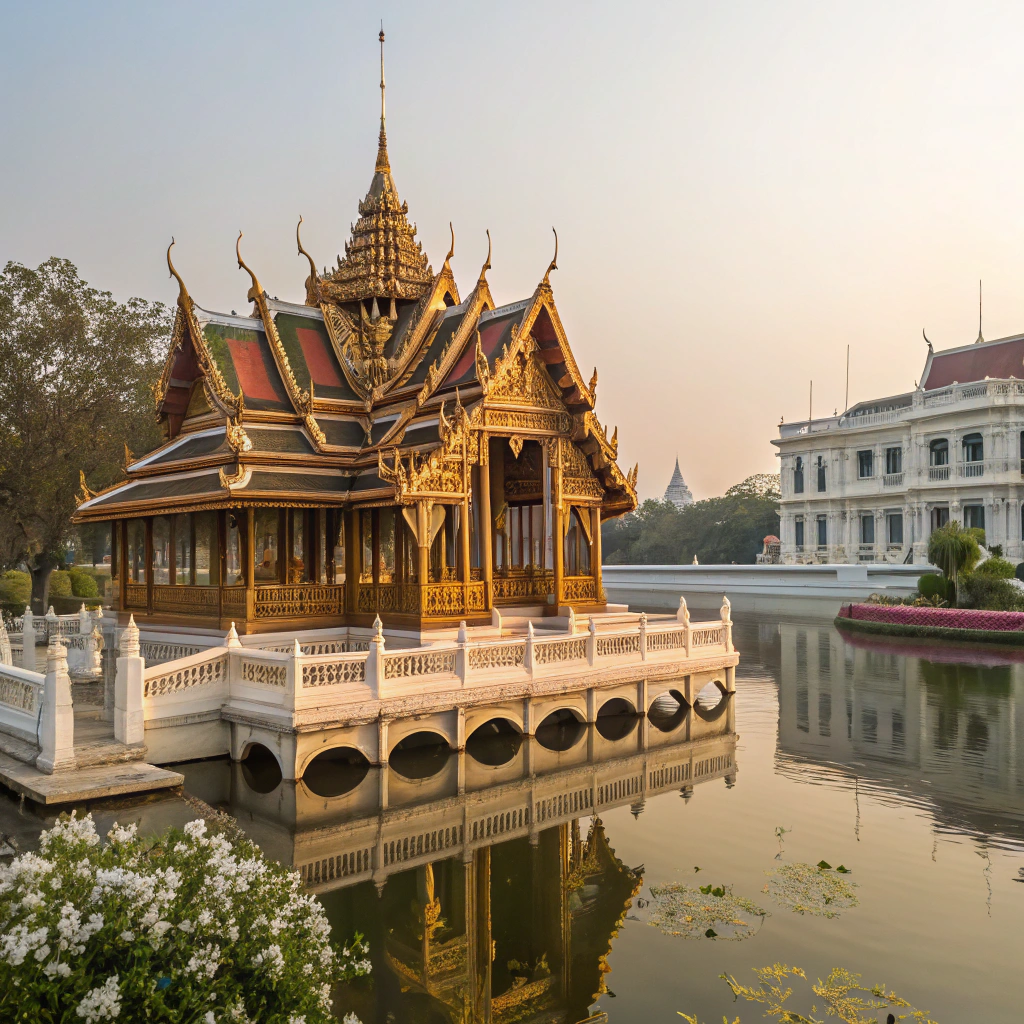
While not all buildings are traditional Bangkok House style, the Divine Seat of Personal Freedom (yes, that’s its real name) is a gorgeous example of a royal Thai pavilion built in the middle of a pond. The contrast between this golden teakwood structure and the European-style buildings nearby perfectly illustrates Thailand’s unique architectural evolution.
Cultural note: You’ll need to dress respectfully (shoulders and knees covered) and you can rent proper attire if needed. Also, be prepared to take off your shoes A LOT as you enter various buildings.
Combine it with: A trip to the nearby ancient capital of Ayutthaya for a full day of historical sightseeing.
Unexpected Encounter: When a Bangkok House Found Me
Sometimes the most memorable travel experiences are unplanned. On my most recent trip to Bangkok in early 2020 (just before the world shut down), I was wandering through the old Talat Noi neighborhood, aimlessly exploring the narrow lanes of this historic Chinese community.
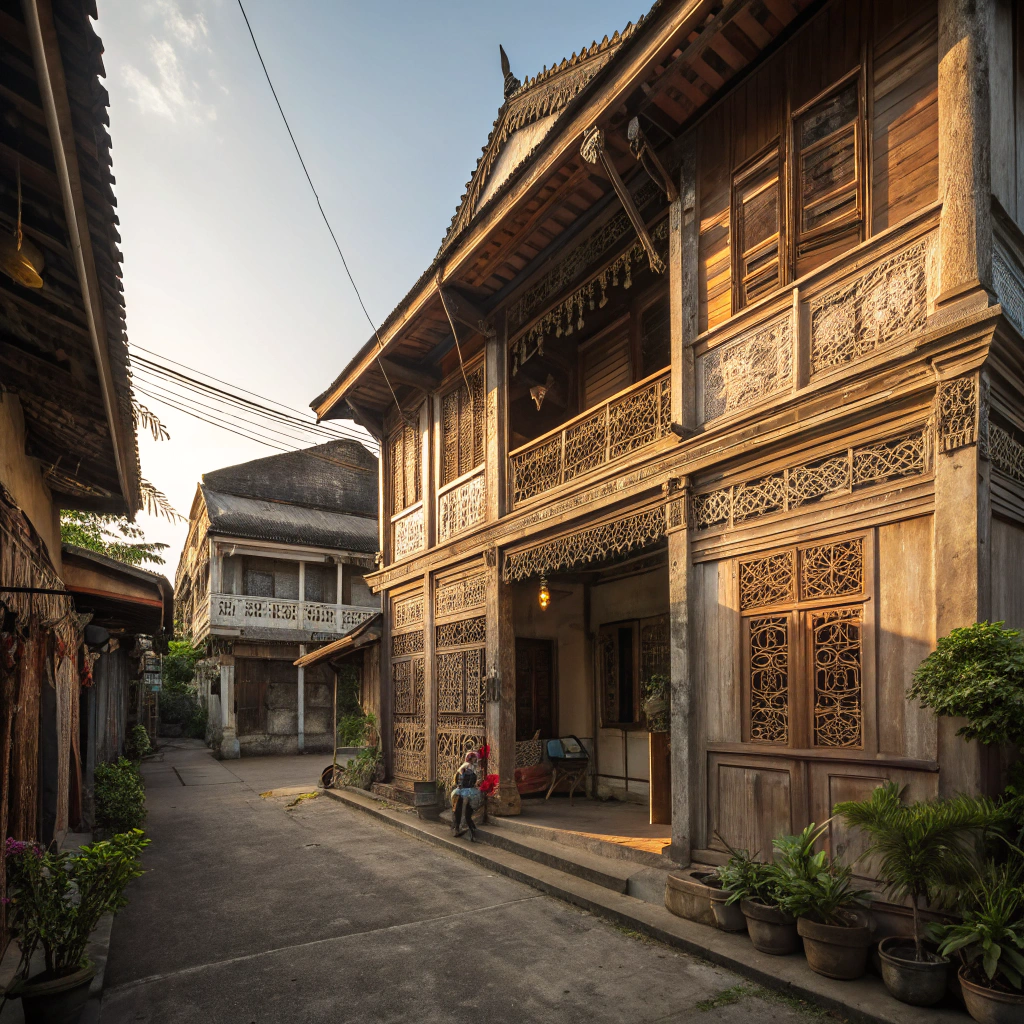
Turning a corner, I noticed an elderly woman sitting outside what looked like a very old wooden house. She smiled and waved me over. Through a combination of broken English, my pitiful Thai phrases, and universal hand gestures, I gathered she was 82 years old and her family had lived in this traditional house for four generations.
Without any prompting, she proudly gave me a tour of her home—a stunning example of a Bangkok House with Chinese influences. The home featured traditional carved panels, a central courtyard, and an ancestral altar gleaming with gold. The wooden floors creaked pleasantly underfoot, polished to a shine by decades of bare feet.
She refused payment but accepted my offer to buy some of the handmade paper flowers her granddaughter was selling. That impromptu 20-minute tour taught me more about how these houses are actually lived in than all my museum visits combined.
I’ve deliberately not shared the exact location out of respect for her privacy, but this experience reinforced something important: sometimes the best way to understand a place’s architecture is to put away the map and just wander. Bangkok still has pockets where traditional life continues behind unassuming facades.
My Love-Hate Relationship with Bangkok House Preservation
I’ve gotta be honest here. While I absolutely adore traditional Thai architecture, I have complicated feelings about how it’s being preserved (or not) in modern Bangkok.
On one hand, organizations like the Association of Siamese Architects are doing important work documenting and advocating for historic buildings. The conversion of old houses into museums, restaurants, and boutique hotels has saved many structures that might otherwise have been demolished.
But let’s face it—Bangkok is developing at warp speed, and traditional wooden houses are disappearing at an alarming rate. When land in central Bangkok is worth its weight in gold, it’s hard to justify preserving a wooden house that takes up precious real estate.
This creates a situation where only the most elite examples of Bangkok House architecture—those with royal connections or exceptional artistic value—get preserved. Meanwhile, the more modest homes that represent ordinary people’s lives are vanishing.
It’s a tricky balance. Cities need to develop, but something valuable is lost when that development erases architectural heritage. I don’t have solutions, just mixed feelings as I watch Bangkok transform with each visit.
Final Thoughts: Why the Bangkok House Still Matters
In a city racing toward the future with skyscrapers and mega-malls, why should anyone care about old wooden houses? For me, it comes down to this: these structures tell stories that glass-and-steel towers never could.
They speak of a Bangkok that understood how to live harmoniously with its tropical environment long before “sustainability” became a buzzword. The elevated designs that allowed floodwaters to pass underneath, the steep roofs that channeled heavy rains, the strategic placement of windows and doors to maximize natural ventilation—these weren’t just aesthetic choices but survival strategies refined over centuries.
Traditional Bangkok House architecture also reflects Thai social values and spiritual beliefs. The hierarchy of spaces, the east-facing orientations, the purposeful use of odd numbers in design elements—all mirror deeper cultural principles that continue to influence Thai society today.
Every time I step into one of these historic houses, I feel a connection not just to Thailand’s past but to a way of thinking about home that prioritized harmony, functionality, and beauty in equal measure. In our world of cookie-cutter condos and disposable design, couldn’t we all use a bit more of that philosophy?
So the next time you’re in Bangkok, take a break from the shopping malls and sky bars. Seek out these wooden treasures, whether in museums, hotels, or hidden neighborhoods. Listen to the stories they tell through their carved details and weathered beams. The modern metropolis is exciting, but the soul of Bangkok still lives in its traditional houses—if you know where to look.
Have you visited any traditional Thai houses in Bangkok? Planning a trip and have questions about which to prioritize? Drop a comment below—I’m always happy to chat about my favorite architectural obsession!
FAQ About Traditional Bangkok House Architecture
What’s the best time of year to visit traditional houses in Bangkok?
The cool season (November through February) offers the most comfortable weather for exploring. Many of these wooden houses can get quite hot during the hot season (March-May), even with fans running. Rainy season (June-October) can actually be magical—seeing traditional houses in the rain helps you appreciate their brilliant design features for handling tropical downpours, but have an umbrella handy!
Are traditional Thai houses disappearing?
Unfortunately, yes. Economic pressures, urban development, and the high maintenance costs of wooden structures mean that traditional houses are increasingly rare in central Bangkok. This makes the preserved examples all the more precious.
Can I visit these houses independently or do I need a guide?
Some, like Jim Thompson House, require you to join their guided tour. Others, like Kamthieng House, can be explored independently. A good compromise is to hire a guide specializing in architecture for your first visit, then return to your favorites to explore at your own pace.
Is there appropriate etiquette I should follow when visiting these houses?
Absolutely! Always remove your shoes before entering any traditional Thai building (look for shoes lined up outside as your cue). Dress modestly, especially in houses with religious elements. Ask permission before taking photos, particularly of any residents. And be mindful that many wooden elements are fragile and irreplaceable—look with your eyes, not with your hands.
What’s a good destination to see traditional houses outside of Bangkok?
If you enjoy Bangkok’s traditional architecture, consider visiting Chiang Mai in northern Thailand. The Lanna architectural style differs from central Thai traditions but is equally beautiful, and more examples have been preserved there than in rapidly-developing Bangkok.
